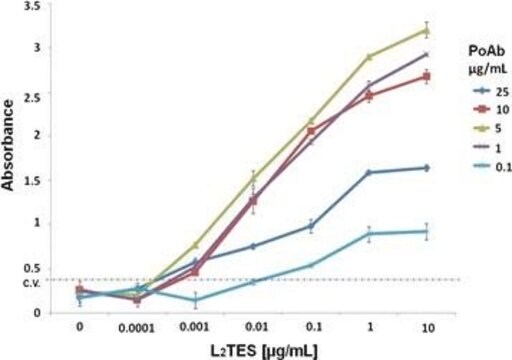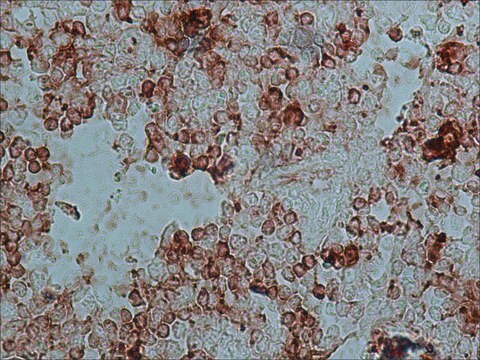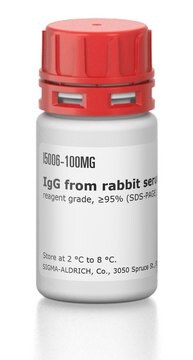R4880
Anti-Rabbit IgG (whole molecule) antibody produced in goat
affinity isolated antibody, lyophilized powder
Iniciar sesiónpara Ver la Fijación de precios por contrato y de la organización
About This Item
Productos recomendados
origen biológico
goat
Nivel de calidad
conjugado
unconjugated
forma del anticuerpo
affinity isolated antibody
tipo de anticuerpo
secondary antibodies
clon
polyclonal
Formulario
lyophilized powder
técnicas
immunoelectrophoresis: suitable
temp. de almacenamiento
2-8°C
modificación del objetivo postraduccional
unmodified
¿Está buscando productos similares? Visita Guía de comparación de productos
Descripción general
Binds all rabbit Igs.
Aplicación
Anti-Rabbit IgG (whole molecule) antibody produced in goat is suitable as secondary antibody in immunoblotting.
Applications in which this antibody has been used successfully, and the associated peer-reviewed papers, are given below.
Western Blotting (1 paper)
Western Blotting (1 paper)
Acciones bioquímicas o fisiológicas
IgG antibody subtype is the most abundant of serum immunoglobulins of the immune system. It is secreted by B cells and is found in blood and extracellular fluids and provides protection from infections caused by bacteria, fungi and viruses. Maternal IgG is transferred to fetus through the placenta that is vital for immune defense of the neonate against infections.
Otras notas
Antibody adsorbed with human serum proteins.
Forma física
Lyophilized from 0.01 M sodium phosphate, 0.015 M sodium chloride, pH 7.2
Reconstitución
Reconstitute with 0.135 M sodium chloride.
Cláusula de descargo de responsabilidad
Unless otherwise stated in our catalog or other company documentation accompanying the product(s), our products are intended for research use only and are not to be used for any other purpose, which includes but is not limited to, unauthorized commercial uses, in vitro diagnostic uses, ex vivo or in vivo therapeutic uses or any type of consumption or application to humans or animals.
¿No encuentra el producto adecuado?
Pruebe nuestro Herramienta de selección de productos.
Código de clase de almacenamiento
11 - Combustible Solids
Clase de riesgo para el agua (WGK)
WGK 3
Punto de inflamabilidad (°F)
Not applicable
Punto de inflamabilidad (°C)
Not applicable
Equipo de protección personal
Eyeshields, Gloves, type N95 (US)
Elija entre una de las versiones más recientes:
¿Ya tiene este producto?
Encuentre la documentación para los productos que ha comprado recientemente en la Biblioteca de documentos.
Los clientes también vieron
On-site quantification of human urinary albumin by a fluorescence immunoassay.
Sunga Choi et al.
Clinical chemistry, 50(6), 1052-1055 (2004-05-27)
M Rudling et al.
The American journal of pathology, 153(6), 1923-1935 (1998-12-10)
The high-affinity degradation of low-density lipoprotein (LDL) is enhanced 3- to 100-fold in leukemic blood cells from patients with acute myelogenous leukemia (AML), suggesting an increased cellular LDL receptor expression. There are, however, inconsistencies regarding the published properties of LDL
Jinsu Kim et al.
ACS applied materials & interfaces, 7(4), 2891-2898 (2015-01-13)
We demonstrated a lateral flow immunoassay (LFA) for detection of viruses using fluorescently labeled M13 bacteriophage as reporters and single-reporter counting as the readout. AviTag-biotinylated M13 phage were functionalized with antibodies using avidin-biotin conjugation and fluorescently labeled with AlexaFluor 555.
Shanshan Huang et al.
Pathology, research and practice, 215(4), 794-800 (2019-01-27)
Numbers of studies have indicated that miRNA-708 plays an important role in many types of cancer. However, the role of miRNA-708 in pancreatic ductal adenocarcinoma (PDAC) has yet to be fully elucidated. The present study aimed to investigate the role
Peter Engelhardt et al.
Methods in molecular biology (Clifton, N.J.), 369, 387-405 (2007-07-28)
Standard immunogold-labeling methods in transmission electron microscopy (TEM) are unable to locate immunogold particles in the depth direction. This inability does not only concern bulky whole mounts, but also sections. A partial solution to the problem is stereo inspection. However
Nuestro equipo de científicos tiene experiencia en todas las áreas de investigación: Ciencias de la vida, Ciencia de los materiales, Síntesis química, Cromatografía, Analítica y muchas otras.
Póngase en contacto con el Servicio técnico










